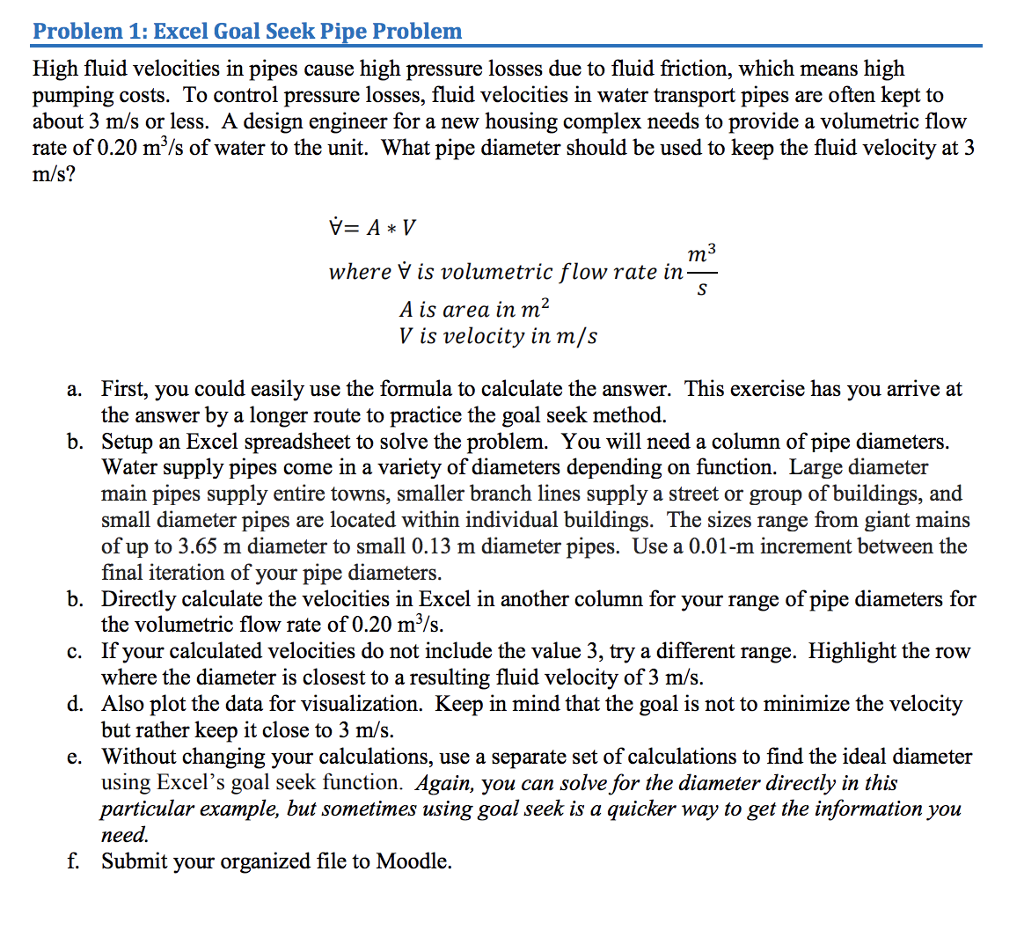
Problem 1: Excel Goal Seek Pipe Problem High fluid velocities in pipes cause high pressure losses due to fluid friction, which means high pumping costs. To control pressure losses, fluid velocities in water transport pipes are often kept to about 3 m/s or less. A design engineer for a new housing complex needs to provide a volumetric flow rate of 0.20 m3/s of water to the unit. What pipe diameter should be used to keep the fluid velocity at 3 m/s? where V is volumetric flow rate in 2 A is area in m V is velocity in m/s First, you could easily use the formula to calculate the answer. This exercise has you arrive at the answer by a longer route to practice the goal seek method. Setup an Excel spreadsheet to solve the problem. You will need a column of pipe diameters Water supply pipes come in a variety of diameters depending on function. Large diameter main pipes supply entire towns, smaller branch lines supply a street or group of buildings, and small diameter pipes are located within individual buildings. The sizes range from giant mains of up to 3.65 m diameter to small 0.13 m diameter pipes. Use a 0.01-m increment between the final iteration of your pipe diameters. a. b. b. Directly calculate the velocities in Excel in another column for your range of pipe diameters for c. If your calculated velocities do not include the value 3, try a different range. Highlight the row d. Also plot the data for visualization. Keep in mind that the goal is not to minimize the velocity e. Without changing your calculations, use a separate set of calculations to find the ideal diameter the volumetric flow rate of 0.20 m3/s where the diameter is closest to a resulting fluid velocity of 3 m/s but rather keep it close to 3 m/s. using Excel's goal seek function. Again, you can solve for the diameter directly in this particular example, but sometimes using goal seek is a quicker way to get the information you need Submit your organized file to Moodle Problem 1: Excel Goal Seek Pipe Problem High fluid velocities in pipes cause high pressure losses due to fluid friction, which means high pumping costs. To control pressure losses, fluid velocities in water transport pipes are often kept to about 3 m/s or less. A design engineer for a new housing complex needs to provide a volumetric flow rate of 0.20 m3/s of water to the unit. What pipe diameter should be used to keep the fluid velocity at 3 m/s? where V is volumetric flow rate in 2 A is area in m V is velocity in m/s First, you could easily use the formula to calculate the answer. This exercise has you arrive at the answer by a longer route to practice the goal seek method. Setup an Excel spreadsheet to solve the problem. You will need a column of pipe diameters Water supply pipes come in a variety of diameters depending on function. Large diameter main pipes supply entire towns, smaller branch lines supply a street or group of buildings, and small diameter pipes are located within individual buildings. The sizes range from giant mains of up to 3.65 m diameter to small 0.13 m diameter pipes. Use a 0.01-m increment between the final iteration of your pipe diameters. a. b. b. Directly calculate the velocities in Excel in another column for your range of pipe diameters for c. If your calculated velocities do not include the value 3, try a different range. Highlight the row d. Also plot the data for visualization. Keep in mind that the goal is not to minimize the velocity e. Without changing your calculations, use a separate set of calculations to find the ideal diameter the volumetric flow rate of 0.20 m3/s where the diameter is closest to a resulting fluid velocity of 3 m/s but rather keep it close to 3 m/s. using Excel's goal seek function. Again, you can solve for the diameter directly in this particular example, but sometimes using goal seek is a quicker way to get the information you need Submit your organized file to Moodle







